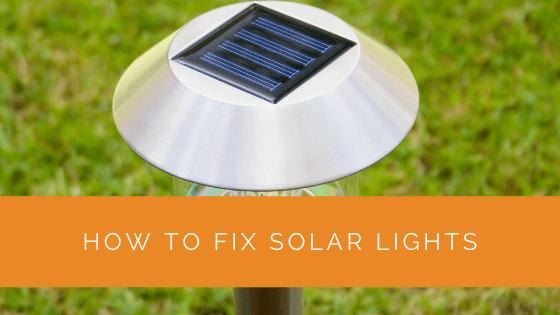When solar lights are brand new, they seem like a terrific idea, but you may have to restore outdoor solar lights when not working. These easy-to-install lights use solar cells to convert sunlight into electricity, which is then stored in batteries to power the lights.
Solar-powered lights, however, have a few flaws that may make them less dependable over time. The most severe problem is a clogged solar panel, which is relatively simple to repair.
First, you should examine your solar lights to see whether they are broken. Cover the solar panel to make it appear that it is night, causing the lights to turn on if they are operable.
Solar lights operate in such a manner that it is turned off when there is enough direct sunlight. This period is utilised to charge the batteries and build up an energy reserve.
When it gets dark, the energy is used to power the lights. If your solar lights aren’t working, another light source may be shining through the panel, providing the misleading appearance that it’s still sun. Seasons change might also affect the functioning.
Sometimes, the solution is as easy as rotating the panel slightly to ensure that the panel’s day or night reading is accurate. You tried moving the lights to a new location, but it didn’t help. It appears like your lights are malfunctioning.
If your solar lights stop working, here are some tips to help your grubby solar panel get back to work.
Contents
- 1 Tips for Repairing Your Solar Lights
- 2 Outdoor Solar Lights
- 3 Inspect The Solar Light
- 4 Replace a Faulty Sensor
- 5 Turn It Off For 72 Hours To Charge
- 6 Examples of Solar Lights
- 7 Case Study: Troubleshooting Solar Light Issues
- 8 Expert Insights From Our Solar Panel Installers About Solar Lights
- 9 Our Expertise in Solar Lights
- 10 Conclusion
Tips for Repairing Your Solar Lights
Cover The Panel
When the solar panel is covered, the lights are fooled into believing night has arrived early and turned on. During the day, solar lights are usually turned off automatically since they convert light into energy to be stored in batteries.
At night time, this energy is needed to keep the lights on. If your light hasn’t turned on after night, cover the panel; if it does, you’ll know another source of light hitting the solar panel, fooling it into believing it’s still daytime.
A small adjustment to the panel placement will sometimes correct the problem and get your solar lights to work properly again.
Replace The Batteries
Did you realise that new solar lights frequently contain standard rechargeable batteries? Modern products should always be rechargeable, such as NiMH or Li-ion batteries.
Because the solar light batteries charge throughout the day and drain at night, they will eventually lose their charging ability when the light is turned on. Even after a sunny day, reduced runtime in the evening hints that something is occurring to your lights.
Good batteries should last for at least one to two years before you need a new battery, although this is merely a guideline. If you discover dead batteries, you must replace them with new ones.
Some customers report that their many solar lights have been on for over six years and are still using the original batteries; however, this is the exception rather than the rule.
Ensure your normal batteries haven’t fallen free from their strip, which is another simple check. They won’t be able to charge if they don’t touch the terminal’s contacts. If you discover a loose battery, give it a couple of days to recharge before using it again.
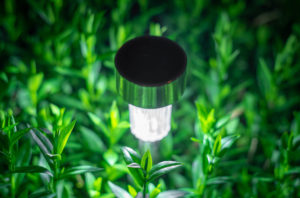
Check For Water Infiltration
Water penetration or water ingress may cause damage to solar lights on occasion. This shouldn’t be a problem if your light is properly designed and constructed.
Your product’s ingress protection (IP) rating indicates how effectively it is protected against moisture. For the greatest possible protection, choose one with a high IP rating.
Water may not always be a problem since many units can let water flow off without contacting the electrics, but if it is, there are a few things you may do to fix the problem:
Remove any covers retaining moisture and place the lamp in an airing cupboard to dry it for a few days. Please put it back together, ensure the batteries are in the right places, and then charge the light for a few days before using it again.
Always read the manufacturer’s directions before doing anything—a properly installed solar light with a guarantee may contain a water ingress restriction.
It implies you may get your light changed by just contacting the manufacturer. You may be asked to give photographic documentation of the problem.
Hungry Squirrels
Customers occasionally bring us photos of creatures that have been hungry and help themselves to some nutritious wire from a string of fairy lights, for example, hungry squirrels.
Electrical tape and patience are sometimes enough to fix the damage. If this isn’t feasible, contact the manufacturer to see if spare parts are available to avoid disposing of the entire product.
When it comes to wire, always leave plenty of slack between branches in any installation where the wire may be subject to strain, such as a string of fairy lights in a tree. Extreme weather can put undue strain on the wire, creating broken wires that are difficult to locate and much more difficult to repair.
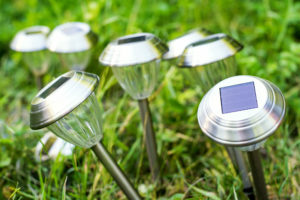
Clean The Solar Panel
The best approach to clean solar panels is using pure water. If it fails, you can use rainfall or low-mineral-content tap water.
Why?
Do not use soapy water. Soaps might leave a film or residue behind that promotes grime to stay and accumulate faster. Worse still, washing solar panels with a strong chemical solution might result in scaling. This can penetrate the frame and destroy the silicon.
Soaps and detergents aren’t the only options.
The steps for cleaning a solar panel are as follows:
- Choose the best time of day for you – when the sun rises or evening is ideal.
- Pre-rinse – removes the dirt and debris from the first layer.
- Scrub – use a gentle yet abrasive scrub.
- Last but not least, rinse away any leftover dirt and debris.
Allow them to dry if you use just pure water naturally. This is because pure water leaves no residue or pollutants behind.
Outdoor Solar Lights
This can happen if your solar lights are entirely or partially shaded by glass, such as a patio or outdoor room’s glass roof. It can also happen if you charge your solar lights before a window.
While we may be able to benefit from the sun by sitting near a window, the same cannot be said with solar panels.
Modern glass has double or even triple-glazed windows to shield people from harmful radiation. However, it renders the sun’s rays worthless when they strike the solar panel, as it only gets passive infrared rays.
Solar panels need enough sunlight and cannot be charged by disappointing light. The ideal spot to put the panel is always outside. To completely charge it, place it somewhere with plenty of direct sunlight.
Inspect The Solar Light
Verify that the solar lights’ switch is firmly plugged and fully in the “on” position. The switch for a solar landscape light can be found on the bottom of the solar light capsule or under the cap.
On certain versions, release the cover from the clear plastic section of the light by turning it counterclockwise.
Set the solar lights in a place where they will receive sufficient sunlight. Please place it in the right direction and at the best angle, facing the sun for many hours after making sure the switch is on, then test it by covering the solar panel with your palm.
The electrical connections between the panel and the lamp may be corroded by moisture within the light, and they can affect the specific voltage needed for the solar lights. It can also affect the batteries. Keep an eye out for corrosion.
You may be unable to repair outdoor solar lights that have stopped operating due to excessive corrosion. You’ll have to get a new light instead.
Check the cable to see whether it’s still in excellent shape if your solar lights are on a string, similar to street lights. Animals have been known to gnaw through the cable. In a rush, you might be able to mend the string light wire by taping the bare portions of each section of the line using electrical tape.
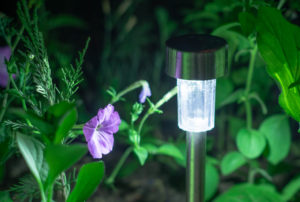
Replace a Faulty Sensor
Solar light sensors might fail for a variety of reasons. The most typical cause for a sensor failing is that it is old and has to be replaced. As with anything else, if something is used frequently enough, it will ultimately break down and must be replaced. A light sensor on your solar light is the same way.
Another possible cause of a defective lux sensor is that it has been damaged somehow. The sensor can be jarred and stop operating correctly if it has been knocked over too many times or struck with anything fairly hard, leaving you with a broken solar light.
A defective sensor is one of the most common causes of your solar light turning on during the day. It may malfunction if you’ve cleaned and dried the sensor well and it’s still turning on during the day.
The good news is that they are virtually always replaceable. If the remainder of the solar light is in fine working order, you can contact the manufacturer to see if replacements are available. This is not just a quick remedy for a solar light that turns on throughout the day, but it’s also a cost-effective option and a great idea.
Turn It Off For 72 Hours To Charge
Your solar light is hard at work converting the sun rays into energy that can be stored in the battery until dusk. Sometimes, you must give your solar light a ‘break’ to recharge and regain its vigour and vitality.
When preventing your solar light from turning on during the day, this is, of course, the final measure. If you’ve done everything else and it still doesn’t work, consider giving it a 72-hour break.
Switch off the solar light completely. You might also want to take the battery out of the solar light and store it in a dark room with no light sources so it doesn’t start charging again.
You can try reassembling the solar light after 72 hours to see if it was the solution to your solar light turning on throughout the night.
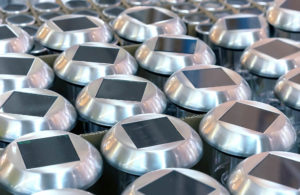
Examples of Solar Lights
- Solar Garden Lights: https://www.solarpanelsnetwork.com/blog/best-solar-garden-lights/
- Solar Festoon Lights: https://www.solarpanelsnetwork.com/blog/best-solar-festoon-lights/
- Solar Gutter Lights: https://www.solarpanelsnetwork.com/blog/best-solar-gutter-lights/
- Solar Fence Lights: https://www.solarpanelsnetwork.com/blog/best-solar-fence-lights/
- Solar Deck Lights: https://www.solarpanelsnetwork.com/blog/best-solar-deck-lights/
Case Study: Troubleshooting Solar Light Issues
Background
A homeowner approached Solar Panels Network with concerns about their solar garden lights, which had stopped functioning. The lights were installed to provide ambient lighting in their backyard, but recently they had ceased to work, even on sunny days.
Project Overview
The primary objective was to diagnose and fix the issue with the solar garden lights. The homeowner had tried simple troubleshooting, such as cleaning the panels and adjusting the positioning, but the lights remained non-functional.
Implementation
- Initial Inspection: Our team started with a comprehensive inspection to check for common issues like dirt accumulation on the panels, proper placement, and possible damage to the wiring.
- Testing the Solar Panel: The solar panels were tested by covering them during daylight to see if the lights turned on. This step confirmed that the problem was not with the sensors misinterpreting daylight.
- Battery Check and Replacement: We inspected the batteries and found that they were no longer holding a charge. The batteries were replaced with new, high-quality rechargeable ones compatible with solar lights.
- Water Infiltration Examination: There were signs of water infiltration in some of the lights. The affected units were dried and resealed to prevent future moisture ingress.
- Sensor Functionality: The sensors were tested to ensure they were accurately detecting light levels and functioning correctly.
Results
- Restored Functionality: The solar lights were successfully repaired and returned to full functionality, providing the desired ambient lighting in the garden.
- Enhanced Longevity: By replacing the batteries and addressing the water infiltration issue, the lifespan of the lights was extended.
- Improved Efficiency: Regular maintenance tips were provided to the homeowner, including cleaning schedules and checks for potential damage, to maintain optimal light performance.
Summary
This case study demonstrates that common issues with solar lights, such as dead batteries and water damage, can be resolved with proper troubleshooting and maintenance. Solar Panels Network was able to restore the functionality of the garden lights, ensuring the homeowner could continue enjoying their outdoor space with reliable, eco-friendly lighting. Our team’s expertise in solar technology ensures that we provide practical solutions and support for all solar lighting needs.
Expert Insights From Our Solar Panel Installers About Solar Lights
Solar lights are a fantastic addition to any outdoor space, providing both aesthetic appeal and functionality. Proper installation and occasional maintenance can ensure they last for many years.
Solar Lighting Specialist
One common issue we see is that people forget to clean their solar panels. Dust and debris can significantly reduce their efficiency, so a simple wipe down can make a big difference in performance.
Solar Installation Expert
If your solar lights aren’t working, it could be as simple as replacing the batteries. Over time, rechargeable batteries lose their ability to hold a charge, so swapping them out can often solve the problem.
Renewable Energy Consultant
Our Expertise in Solar Lights
At Solar Panels Network, we’re here to provide you with valuable information and support regarding solar lighting. With our experience and understanding of the solar lighting industry, our team of experts is prepared to assist you in finding the right lighting solution for your needs. Whether you’re interested in improving your outdoor spaces, conserving energy, or adopting a more sustainable approach, we’re well-equipped to help. Please feel free to contact us with any questions or inquiries.
Conclusion
It doesn’t have to be difficult to repair solar lights if your solar lights are not working. Sure, you could run into some difficulties with them at some point. However, They don’t usually confront you with challenges you can’t solve.
We hope you have found this article helpful; you have either gotten your lights working properly or, at the very least, have a simple fix to get them back up and running.
Always remember that if your solar lights have the best protection of a 12-month guarantee, as all excellent solar lights should be, you’ll have a replacement on its way to you in no time if you’ve followed the instructions.
About the Author
Solar Panels Network stands at the forefront of solar energy solutions, driven by a team of seasoned solar engineers and energy consultants. With over decades of experience in delivering high-quality solar installations and maintenance, we are committed to promoting sustainable energy through customer-centric, tailored solutions. Our articles reflect this commitment, crafted collaboratively by experts to provide accurate, up-to-date insights into solar technology, ensuring our readers are well-informed and empowered in their solar energy decisions.

